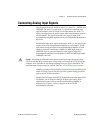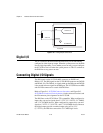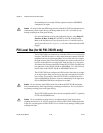
Chapter 2 Hardware Overview of the NI 7831R
© National Instruments Corporation 2-13 NI 7831R User Manual
In single-ended input modes, electrostatic and magnetic noise couples into
the signal connections more than in differential input modes. The coupling
is the result of differences in the signal path. Magnetic coupling
is proportional to the area between the two signal conductors. Electrical
coupling is a function of how much the electric field differs between the
two conductors.
Single-Ended Connections for Floating Signal
Sources (RSE Input Mode)
Figure 2-8 shows how to connect a floating signal source to a channel on
the NI 7831R configured for RSE input mode.
Figure 2-8. Single-Ended Input Connections for Nonreferenced or Floating Signals
Single-Ended Connections for Grounded Signal
Sources (NRSE Input Mode)
To measure a grounded signal source with a single-ended input mode, you
must configure the NI 7831R in the NRSE input mode. Then connect the
signal to the positive input of the NI 7831R instrumentation amplifier and
connect the signal local ground reference to the negative input of the
instrumentation amplifier. The ground point of the signal should be
connected to AISENSE. Any potential difference between the NI 7831R
ground and the signal ground appears as a common-mode signal at both the
RSE Input Mode Selected
–
+
–
+
–
+
Floating
Signal
Source
I/O Connector
AISENSE
AIGND
V
m
Measured
Voltage
Instrumentation
Amplifier
x8 Channels
AI+
AI–
V
s


















